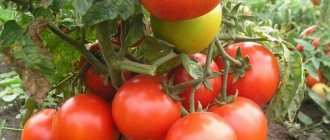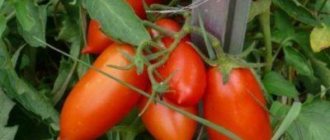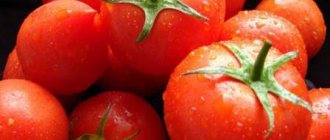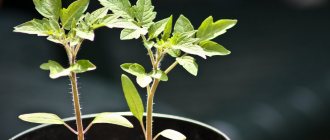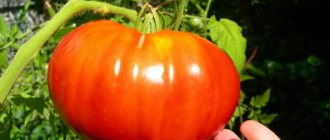Today, most housewives are trying to purchase Betalux tomatoes. This is due to the fact that it produces large fruits and is not picky in care. This and much more makes it irreplaceable. Betalux of Polish selection, bred for outdoor cultivation, has all the qualities necessary for this.
Characteristic:
- Low height, which means it does not require installation of supports or tying.
- Ripens early, approximately 50% of the crop ripens in the first twenty days.
This allows you to have time to collect them before late blight appears.
Description:
- the fruits are not large;
- have a round shape;
- Red color;
- thin-skinned.
Up to two kilograms of fruit are removed from plants grown in open ground. Suitable for fresh eating and for making home canned food. It does not need to be pinched, just remove the lower stalks when planting seedlings.
Growing from seedlings
In order for Betalux tomato seedlings to emerge on time, the owner plants them two months before planting them in the ground. It is better to use purchased soil for seedlings, as it does not require any preparation. Seeds are sown in special dishes or in adapted boxes, watered and covered with transparent lids or film. These containers should be placed in a well-lit place, usually on a windowsill. Additional artificial lighting will not hurt either. With the appearance of real leaves, you can start diving into cups.
Bush care
Basic care measures:
Water for the first time 10 days after transplantation. Then, before flowering begins, watering is carried out as the soil layer dries, spending from 3 to 4 liters per 1 m2. During active fruit formation, the hybrid needs more abundant watering. Water consumption increases to 10-12 liters per 1 m2. It is strictly forbidden to use cold water, as well as stagnant, stale water. This will provoke the occurrence of diseases. Only warm, settled water is recommended for irrigation. During active fruiting and fruit ripening, the frequency of watering is once every 5-7 days; Feed the bushes in a timely manner, alternating mineral complexes and organic fertilizers; Regularly loosen the soil near the bushes and between the rows; Mulch the soil with straw or mown grass; Destroy weeds;
Tomatoes are pollinated naturally. However, to increase productivity, it is recommended to additionally carry out mechanical pollination.
For this purpose, the branches of the bushes are carefully shaken periodically. It is advisable to carry out these procedures during the daytime, on a bright, sunny day.
After the manipulations, the flowers are sprayed, and the greenhouse room is well ventilated;
The greatest results can be achieved when maintaining a bush with one or two stems.
- A tall bush needs to be tied to a vertical support or trellis;
- Also, do not forget to regularly ventilate the greenhouse structure. For this purpose, the premises must be equipped with windows.
Landing in the ground
The beds need to be prepared in the fall; superphosphate and potassium, as well as humus and ash, are added during digging. In the spring, loosen again by adding nitrogen fertilizers. Two days before planting, you need to water the soil with copper sulfate. 5–6 plants are placed per square meter. After watering, cover the soil around with mulch so that the soil does not dry out and a soil crust does not form. You can mulch with sawdust mixed with humus, straw, and mown grass, but only if there are no seeds in it, otherwise weeds will grow.
See also
Description of the Cherokee tomato variety, its characteristics and yieldRead
Agricultural technology of tomatoes Novichok
Growing Novichok tomatoes is no more difficult than other varieties of tomatoes. Depending on the growing area, they are suitable for beds, greenhouses, greenhouses or film shelters.
Growing Novichok tomatoes is no more difficult than other tomato varieties.
The process begins with sowing seedlings. If you grow it yourself, you can start sowing seeds from mid-March until the first ten days of April. The period is chosen in such a way that by the time the tomatoes are planted in a permanent place, the age of the plants is 50–60 days. This usually happens in the second half of May, when the likelihood of frost has passed.
To obtain friendly shoots:
- First, weak and diseased seeds are discarded by immersing all seed in a saline solution (1 teaspoon per glass of water). After a quarter of an hour, the healthy seeds will sink to the bottom of the vessel, and the unusable ones will remain on the surface.
- They are drained with part of the water, and the good ones are filtered through a cloth, washed several times with clean water, and dried.
- Before sowing, the seeds are disinfected in a weak solution of potassium permanganate.
Soil for seedlings can be purchased or prepared independently by mixing:
- garden soil - 1 part;
- humus - 2 parts;
- mullein - 1 part;
- peat - 6–7 parts.
After filling the containers for growing seedlings with soil, it is recommended to spray it with a solution of a growth stimulator in the concentration specified in the instructions (Epin-extra, Kornevin, Zircon, Silk, Sodium Humate or another).
When landing, proceed as follows:
- The seeds are buried approximately 1–1.5 cm into the soil.
- Sprinkle them with a thin layer of earth.
- Cover the container with a transparent film or glass and place it in a warm place with a temperature of about 23–25 ºС.
- After the emergence of seedlings, the shelter is removed.
With the appearance of the third true leaf, the seedlings are planted in separate containers for each plant (if the seeds were not planted in separate containers).
Water as the top layer of soil dries
It is important not to flood the seedlings - this can lead to the development of a black leg and the death of the seedlings
The seedlings are fed twice during the growing period:
- 12–14 days after diving, 4 g of ammonium nitrate, 30 g of superphosphate, 8 g of potassium chloride are added per 1 m2 of soil area;
- after another three weeks, the amount of fertilizer is doubled.
About 10 days before placing the seedlings on the garden bed, they begin to harden them, first taking them out into the open air or balcony for two to three hours, then increasing the duration of hardening to a whole day.
Plants are planted according to a 0.4 × 0.5 m pattern.
Tomato seedlings are planted according to a 0.4×0.5 m pattern
Since tomatoes are very demanding on soil fertility, 10–15 days after planting in the ground, the plants begin to be fertilized:
- the first fertilizing for bush growth is carried out with a fertilizer containing nitrogen and sulfur - ammonium nitrate - in the volumes and concentrations specified in the instructions for the fertilizer; you should not overfeed the bush with nitrogen, otherwise it will grow a lot of greenery to the detriment of yield;
- During the flowering period and the beginning of ovary formation, potassium and phosphorus fertilizers are applied. It is best to use potassium monophosphate (one of the most concentrated phosphorus fertilizers, which also contains a lot of potassium) in a proportion of 10 g per 10 liters of root water;
- Then, throughout the entire fruiting period, the tomatoes are fed with ash, which accelerates the ripening of the fruit and improves its taste. The easiest way is to sprinkle ash around the bush, then water it well and loosen the soil.
Watering is needed moderately, depending on the weather, 1-2 times a week. To prevent diseases, it is recommended to combine one of the weekly waterings with treating the soil with potassium permanganate in order to prevent diseases of tomatoes. To do this, take 5 g of potassium permanganate per 10 liters of water. After watering with water, add a glass of potassium permanganate solution under each plant.
Loosening and weeding necessary for tomatoes can be replaced by mulching the ground with a 5-centimeter layer of organic matter (hay, wood shavings, peat, and so on).
Seedless cultivation
Betalux tomatoes are also ideal for growing without seedlings in open ground . In order for the earth to begin to warm up, you need to prepare a warm bed in advance. It is better to place manure on the bottom, which Betalux tomatoes do not like, but not completely rotted plant residues. The layer of soil on top should be about twenty centimeters.
Before sowing Betalux tomatoes, water the soil with a warm solution of light pink potassium permanganate. The holes are made in a checkerboard pattern, five seeds are laid out in each, sprinkled with earth one and a half centimeters and watered with warm water. Each hole needs to be covered with a cut plastic bottle, covering material should be placed on them, arcs should be installed on the bed and covered with film on top.
Under such shelter, both heat and moisture are well preserved, so Betalux tomatoes do not need to be opened until shoots emerge. The film is removed depending on the weather. Excess plants in the holes need to be pulled out and replanted.
Advantages of seedless cultivation:
- There is no need to grow seedlings at home or buy who knows what on the market.
- There is no need to harden the plants, they will do it themselves.
- They will not be injured or sick from the transplant.
- You can then collect your seeds from these plants.
- There is no need to bother with transplanting seedlings, carrying heavy boxes from home, or shading them after planting.
Consumer properties of Betalux tomatoes
The ovaries are formed on simple or double racemes, 4-5 pieces on each branch. Fruits of equal size ripen at the same time. The weight of 1 tomato rarely exceeds 100 g. The shape is round, without pronounced ribbing. The color of a ripe tomato is bright red; when technically ripe, the fruits are pale green, with a spot at the stalk. In open ground, greenish areas may remain on the hangers.
Video: TOMATOES FOR THE LAZY! This variety does not get sick and does not require pinching or gartering.
Video: THE BEST VARIETY OF LOW GROWING TOMATOES!
The skin is strong, but not thick. Tomatoes are not subject to cracking when filling and ripening, and tolerate transportation well even when ripe. The shelf life of the fruit reaches 5-7 days, and blanc tomatoes can be stored and gradually ripen for 2 weeks.
The pulp is tender, its structure resembles a ripe melon, the tomatoes are juicy and fleshy. The structure of the fruit can be classified as beef tomatoes. The seed chambers are small and there are few grains. The color of the pulp is intense and uniform, without light areas in the middle.
The taste of a ripe tomato is sweet and sour, classic, with a pronounced characteristic aroma.
These tomatoes have a universal purpose. The early ripeness of the Betalux variety makes it indispensable for fresh consumption. From bright, juicy and tasty tomatoes you can prepare a variety of salads, snacks, and gazpacho. The well-colored pulp is suitable for hot sauces, vegetable caviar, borscht dressings and soups. Small tomatoes are convenient to bake and stuff.
Betalux is an ideal variety for winter harvesting. Small calibrated tomatoes look great in canned form and successfully complement assorted vegetables. The thick skin does not burst, and the pulp retains its structure and does not spread. Ripe fruits are processed into juice or sauces. The pulp from fleshy tomatoes becomes quite thick; it can be boiled to the desired state in a short time, which ensures the preservation of almost all vitamins.
Agricultural technology
- Watering and loosening
It is enough to water a tomato variety like Betalux four times a season: when planting, a week after planting, and two more times in July. If the weather is hot, you will have to water more, no more than once a week, but generously. This should be done in the evening, the water should be settled and warm. Water at the roots, not on the leaves. Betalux tomatoes need to be hilled during their growth, this will increase the root system and saturate the roots with oxygen. After each watering, loosening is necessary to break up the soil crust.
See also
Description of the tomato variety Atol, its characteristics and productivityRead
- Top dressing
If enough fertilizer has already been applied before planting, then you can only add an infusion of manure and ash, or a herbal infusion with the addition of the same ash, several times. You can prepare banana dressing. Banana peels need to be baked and ground. Sprinkle this “flour” around the roots.
It is recommended to do the first feeding three weeks after planting in the ground, the second when color begins to appear on the second cluster, and the third when flowers appear on the third cluster.
The Betalux tomato variety is a self-pollinating crop, especially if grown in open ground. But it is still worth attracting insects for pollination, because at low temperatures there may be problems with pollination. To do this, you need to plant, for example, basil and coriander between the bushes. These herbs will help improve the taste of Betalux tomatoes. In addition, the bushes sometimes need to be shaken.
Description and characteristics of Betalux tomato, reviews, photos
Ultra-early ripening (95 days from germination to the beginning of ripening), low-growing , determinate tomato variety for open ground.
The bush is powerful, up to 50 cm high , and does not require pinching. Garter to a support - if desired, the bush can collapse under the weight of the fruit.
Basic qualities of fruits
The fruits are round and flat-round, red at maturity, weighing 60-100 grams , juicy, sweet and sour.
The skin on the fruit is not hard. These tomatoes are suitable for early fresh salads, canning, and processing. Productivity : up to 2 kg of fruits from 1 plant (with proper agricultural technology).
The variety manages to produce a harvest before the onset of late blight. The fruits have a high content of vitamins and lycopene.
Currently, this variety is not included in the State Register of the Russian Federation.
Seed producer : Sedek agricultural company.
Features of cultivation
Sowing the seeds of this variety of tomatoes for seedlings is carried out 55-60 days before the intended planting in the ground. When planting seedlings in a permanent place per 1 sq. It is recommended to place up to 6 plants per meter of land.
Further care for tomatoes consists of timely watering, fertilizing with complex mineral fertilizers, weed removal and preventive measures to protect the crop from diseases and pests.
To get an earlier harvest of tomatoes of this variety, you can carry out partial pinching (up to the first bunch).
If you grew Betalux tomatoes, please write what impression you got of them. What was the yield and taste of the fruits like under your climatic conditions? If possible, attach to the comment a photo of the entire bush as a whole or individual fruits that you grew. Thank you!
Your reviews of the Betalux tomato and additions will help many gardeners evaluate this variety more objectively and decide whether it is worth planting or not.
Description of the tomato variety Yasha Yugoslavsky, features of plant care
This tomato variety has its own history. He gained fame in the USA, but he came to the country from Yugoslavia. Recommended for growing in a greenhouse in cool countries, and in the ground in warm countries. Its peculiarity is that the Yasha Yugoslav tomato has a powerful, tall bush. For this reason, for good fruit development, it should be tied to a support. He also needs stepsoning.
The only drawback is the tendency for flowers to become terry. This leads to the fact that the fetus can double, and sometimes even build. This phenomenon is bad because the appearance deteriorates, the taste deteriorates and the skin thickens. The plant spends a lot of effort on their formation, which has a bad effect on the rest of the harvest. Often this negative phenomenon is attributed to improper care. In order for the fruits to be the same, you should follow the watering regime and promptly remove the terry buds that appear.
It is better to form the plant into bushes of two stems. They will be easy to care for and convenient to harvest.
Characteristics of the variety
This type of tomato has mostly positive reviews and excellent characteristics. This is explained by the fact that it has large, tasty fruits of pink-raspberry color.
The description of the fruit also sounds delicious. Their pulp is dense, with a small number of grains. It is juicy, sugary at the break, there are no veins in it. The weight of one tomato can reach up to half a kilogram, but most specimens weigh 300–350 grams.
The yield of the Yasha Yugoslavsky tomato is high. It is great for growing in a greenhouse. The bush can reach a height of up to 1.8 meters. His leaf is simple.
It is better to plant seedlings. To do this, it is worth pre-sowing it 2 months before planting. According to the ripening period, the tomato is mid-season.
Although the bush is extremely tall, this does not affect its productivity. Its branches are completely covered with fruits. They are approximately the same size and have a peculiar heart-shaped shape.
This variety contains many vitamins, minerals and nutrients, so it is well suited for various salads. It is ideal for juices. But it is better to consume it fresh; from heat treatment it loses the elements necessary for the human body.
Features of care
Since this variety is considered rare in our area, not all gardeners are familiar with it.
In order to get an earlier and higher-quality harvest of tomatoes, you need to plant them. This will allow the beneficial substances not to escape into the foliage. Stepchildren should be removed up to 5 centimeters, otherwise you will injure the plant. Stepping is carried out once in the last days of July.
Proper absorption of nutrients in tomatoes directly depends on watering. In open ground you need to water a couple of times a week. If the bush grows in a greenhouse, then no more than once every seven days. For irrigation, it is better to use settled water, but the ideal option is rainwater.
Those who have already tried to grow this variety note that in extreme heat its leaves burn and yellow shoulders form on the fruits. Gardeners also pay attention to the fact that when the branches are not too strong, the brushes need to be tied up.
dachamechty.ru
Features of care
Seeds are sown for seedlings in early March. The seed is planted with a depth of 1 cm, the optimal temperature for germination is 25-26 degrees.
Seedlings are heat-loving; it is better to grow them under film and use a lamp for additional illumination. Regular feeding with an aqueous solution of mineral fertilizers is required.
Nitrogen-containing complexes should not be overused; preference should be given to phosphorus-containing fertilizers.
There are a huge number of ways to grow tomato seedlings. We bring to your attention a series of articles on how to do this:
- in twists;
- in two roots;
- in peat tablets;
- without picking;
- using Chinese technology;
- in bottles;
- in peat pots;
- without land.
Planting in the greenhouse occurs in mid-May. The bushes are placed at a distance of 40-50 cm and a space between rows of 60 cm. A few days after transplanting, you need to tie the plants to supports.
A circular net or strong stakes that hold heavy fruits are suitable for them. Requires pinching with removal of most side shoots. For successful development of ovaries, it is recommended to remove the lower leaves.
General characteristics of the plant
The variety is ultra-early, super-determinate. This type of plant usually bears fruit quickly and completely completes the growing season in 2-3 weeks. Reviews from gardeners who worked with Betalux in open ground indicate the ability of the variety to produce 2 harvests and bear fruit until autumn.
The first ripened tomatoes (several berries from each bush) are harvested 1 month after planting the seedlings. In greenhouse conditions, this can be done as early as mid-June. The period of 90-95 days declared by the manufacturer from sowing to ripening is fully maintained; Betalux tomatoes are one of the first to produce a harvest.
The main yield of the harvest begins 10-15 days after collecting the first fruits. The most abundant harvest will be about 4 kg per 1 m² (5-6 bushes). The next fruiting will begin on the stepsons 2 weeks after harvesting the first tomatoes and will be slightly smaller. The last saturated ovaries can be removed in mid-August, after which the plant’s growing season ends. The total yield per unit area is about 6-7 kg.
The bushes are compact, in open ground they do not exceed 30 cm in height, but in a greenhouse they can be larger - up to 50 cm. The plant has a rigid stem, it can be grown without pinching and without tying it to a support.
The Betalux tomato variety is resistant to cladosporiosis and alternaria, does not suffer from cold and is able to tolerate temperatures below +10°C without loss of yield. Late blight is practically not affected, managing to give up most of the harvest before its mass spread. Removing old leaves accelerates the ripening of fruits and serves as a prevention of late blight.
Characteristics of the variety
The variety has all the necessary properties for good growth and development of fruits, which is why many summer residents and vegetable growers fell in love with it. It can be found in many areas and gardens, because the use of the plant’s fruits is distinguished by its versatility.
Description of fruits and bushes
The variety has indeterminate bushes. This means that he has unlimited growth. New brushes will produce a large volume of ovaries. The height of the bush reaches 1.5-1.7 m in greenhouse conditions and in open ground. With proper care, the bushes grow up to 2 m. The stems are dense and strong, light green in color. They grow quickly and strongly in height and width.
The Andreevsky Surprise tomato has an average number of leaves. They stay on the stems for a long time and cover the fruits. The color is dark. Young leaves are soft and light, mature leaves are dense and wide, rough to the touch. Due to their structure, they are weakly susceptible to attack by aphids.
During flowering, the plant is covered with hundreds of small and light flowers. They do not have a characteristic aroma.
The fruits are not very different from other varieties. They are round and fleshy, with clearly visible ribs, slightly flattened on top. Ripe tomatoes acquire a bright red color, less often with a pinkish tint. The pulp is juicy and aromatic. The weight of the fruits can reach 300-600 g.
They have excellent characteristics and presentation, do not deteriorate during transportation and do not lose their taste. The peel is thin and prone to cracking if the fruit is too large. It is smooth and elastic, without plaque.
Taste
Tomatoes of this variety are widely known not only for their unusual appearance, but also for their taste. Ripe fruits have a characteristic tomato taste, they have a low acid content, but a sufficient percentage of sugar. This is what makes vegetables taste so good. A significant plus of the variety is that the taste is not lost for a long time.
Productivity and fruiting
This variety is not distinguished by a large number of fruits
St. Andrew's surprise is classified as a late-harvest tomato. The first fruits appear 4 months after planting the seedlings and 5-5.5 months after sowing the seeds.
Unfortunately, the plant is not distinguished by high yield volumes, but this minus is compensated by the size of the fruits (they reach 400-500 g) and their taste. With proper care, incl. With proper and regular fertilizers, the crop can produce up to 8 kg of yield. However, there will not be too many vegetables themselves.
To improve the quality of yield, gardeners advise forming 1-2 fruiting stems. 3-5 tomatoes can grow on one bunch, in rare cases - 6.
Low temperature resistance
The main disadvantage of the variety is frost intolerance. The plant dies during sudden frosts and stops developing at low positive temperatures. Therefore, it is more common in the southern regions. There, tomatoes are easier and more convenient to grow in open ground.
In colder areas this species is also cultivated. It is placed in greenhouses. However, in such conditions, gardeners need to carefully monitor the crop and take into account that the yield will be lower. When planting, the tomato is immediately tied up and the stems are formed so that the fruits produced will delight you with taste and volume.
Resistance to diseases and pests
According to the description of the St. Andrew's Surprise tomato, due to the structure and structure of the leaves, the crop is weakly susceptible to attacks by insects, which can quickly destroy the crop and fruit-bearing stems. They create an uninhabitable environment for the pest.
Fortunately for vegetable growers, the variety is resistant to late blight. This fungal disease, which destroys most of the crop, is dangerous because it is transmitted through the seeds to the subsequent harvest.
Area of application of fruits
Due to their taste and characteristics, vegetables are used both fresh and as winter preparations. They are perfect for summer salads and fresh dishes. They retain their taste remarkably well in preserves and pickles. Tomatoes of this variety produce good tomato juice - light and aromatic.
Advantages and disadvantages
The pros of this variety significantly outweigh the cons. That is why many gardeners prefer this variety.
The positive characteristics of the St. Andrew's surprise tomato include:
- large fruit sizes;
- resistance to many fungal and infectious diseases;
- strong root system;
- high storage and transportation rates;
- versatility of using tomatoes;
- excellent development both in open ground and greenhouse conditions.
The disadvantages include:
- special thermophilicity;
- average yield;
- low frost resistance.
Advantages and disadvantages
Any variety is chosen based on its merits. Any modern variety has its advantages. We will try to list them all:
- The fruits ripen early.
- The skin of the fruit is strong, so Betta tomatoes tolerate transportation well; they absolutely do not lose their presentation during transportation to another place.
- Growing Betta tomatoes requires minimal care from the gardener . This is good news. In summer there is always a lot of other gardening work.

